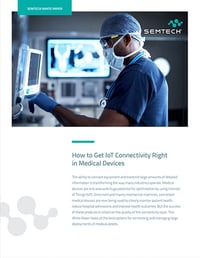 How to get IoT Connectivity Right in Medical Devices
How to get IoT Connectivity Right in Medical Devices
In the past, the IoT was primarily used to help control and operate medical equipment, and to aid in the display of information. Now, with the evolution of cellular technologies, data analytics and computer processing power, the IoT is being used to capture and transmit huge amounts of medical information across a range of devices.
For instance, connected monitors and scanners located in hospitals can instantly send real-time data to doctors on a patient’s condition. Sensors can be used to track the location of equipment like critical care beds or oxygen pumps or ensure hygiene regimes are maintained. Remote monitoring of out-patients can reduce the length of hospital stays and prevent re-admissions. Members of the public are also increasingly using wearable devices to track indicators like blood pressure or glucose levels.
In order to harness the data opportunity and improve outcomes for patients, those designing IoT deployments have to think very carefully about the connectivity layer.
Download this white paper to learn more about:
- The Five C’s of Connectivity: Coverage, Complexity, Cost, Control and Consistency
- How to simplify your Internet of Medical Things (IoMT) deployment
- Ensure resilient and reliable connectivity across your entire deployment of connected medical devices